What a way to make a living
Amelia Groom
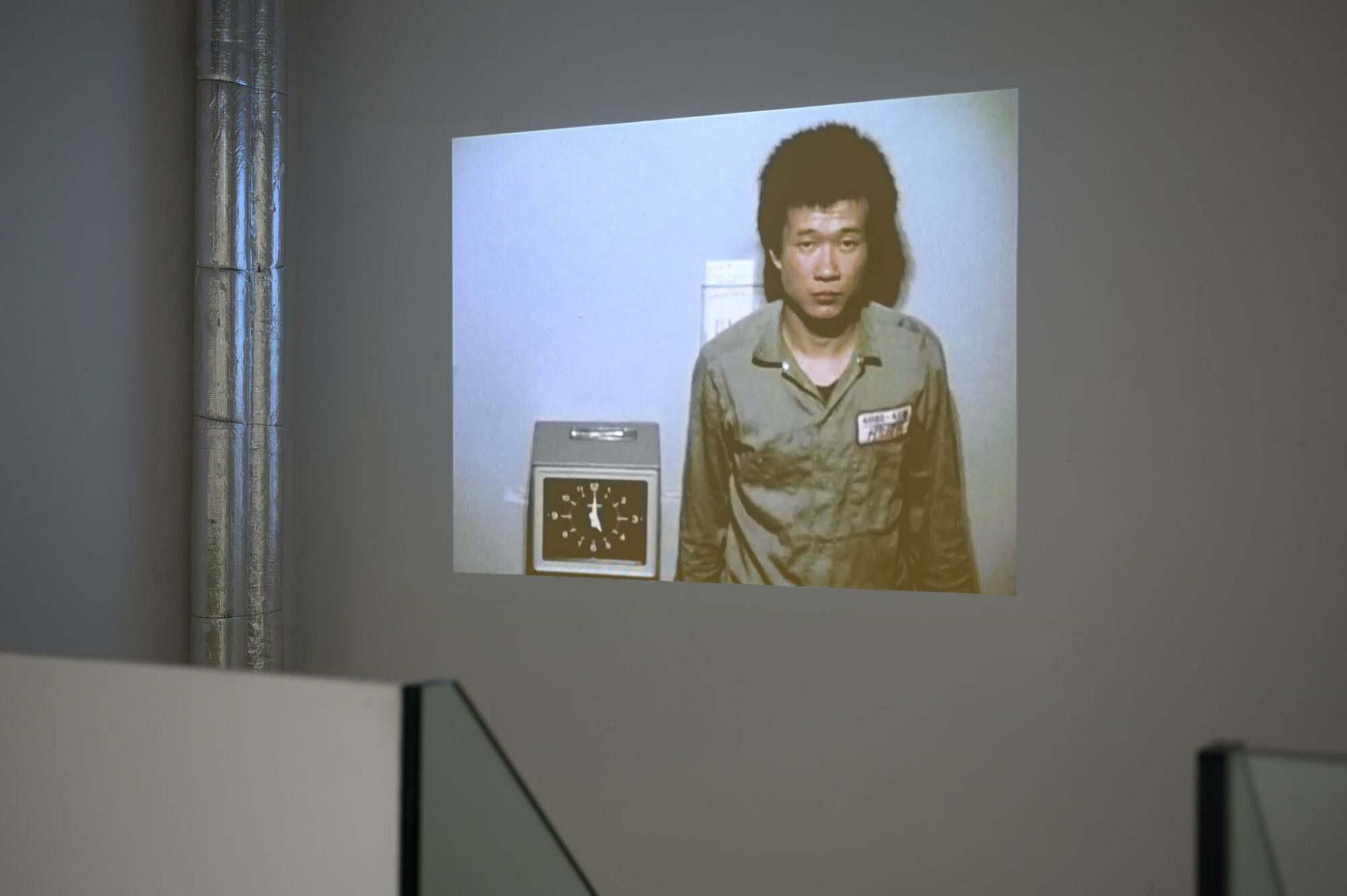
For his One Year Performance 1980–1981: Time Clock Piece (1980–1981), the artist Tehching Hsieh set out to register his arrival at a worker’s time clock in his Manhattan studio, every hour, on the hour, day and night, for an entire year, beginning on 11 April 1980. He photographed himself each time he “clocked in,” and the 8627 resulting images were then made into a time-lapse film, condensing 365 days into 6 minutes.
At the foreground of the work’s multiple temporal registers are two standard units of time: the hour and the year. But while the imposed mechanical structure of clock-time is perversely obeyed across an entire annual cycle, other temporal measures are completely disregarded. Units that are longer than an hour but shorter than a year—weeks, months, seasons—are bypassed, and diurnal rhythms of light and dark—perhaps our most primal marker of time’s passage—as well as the body’s circadian rhythms and sleep patterns, are overridden. As a result, Hsieh’s performance is one of always being right on time while also becoming totally out of sync with the rest of the world.
The time-lapse film shows the hands of the clock device whirling menacingly through the abstract temporal units of hours and minutes, while the body that tries to obey the clock becomes a site that registers other kinds of times. We see the artist’s hair grow out, and we see the enfleshed temporalities of endurance and exhaustion, as he becomes more and more pallid and bleary-eyed over the 365 days. The 133 punches that Hsieh failed to make, out of the 8760 hours that are in a year, are also a crucial component of the work, because they are the corporeal slippages where the full internalisation of clock-time is shown to be unachievable.
A coincidence: during the months when Hsieh was in his studio punching away at the time clock, Dolly Parton’s hit single 9 to 5 (1980) was saturating the airwaves. The song appeared on 9 to 5 and Odd Jobs (1980), a concept album about work which also featured covers of working class folk and country classics like Merle Travis’s Dark as a Dungeon (1947), a rallying song among unionized coal miners, and Woodie Guthrie’s Deportee (Plane Wreck at Los Gatos) (1948), a lament for 28 migrant farm workers who died in a plane crash while being sent from California back to Mexico (“You won’t have your names when you ride the big airplane / All they will call you will be ‘deportees’”).
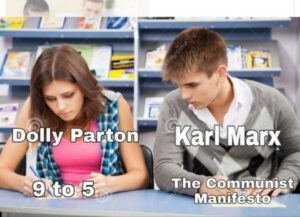
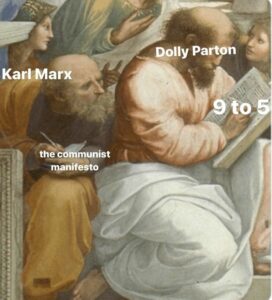
The song 9 to 5 was written for the film of the same name—a feminist revenge comedy which was released in 1980, with Parton, Jane Fonda, and Lily Tomlin playing three overworked and underestimated company employees who manage to kidnap their “sexist, egotistical, lying, hypocritical bigot” boss and run the office on their own. The film came out of Fonda’s production company IPC Films, which was named after her antiwar organization Indochina Peace Campaign. The title 9 to 5 came from an association for women office workers founded in Boston in 1972, which eventually formed the national union SEIU 925. Fonda had known some of the women involved in the organization through her involvement with the antiwar movement, and their stories inspired her to make the film.[1]
The song plays through the film’s opening sequence, and right away, time is depicted as a problem. Parton apparently wrote the song while she was between takes on the set, tapping her long, acrylic nails together for the percussive clicking that runs throughout (her nails are credited as a musical instrument on the album’s liner notes). The fast clicking resembles the sound of typewriters, as well as the sound of ticking clocks—and throughout the film’s opening credits, clocks are everywhere. A montage sequence with different alarm clocks going off in the morning is followed by a series of shots of women in skirt suits and high heels, rushing through the city to make it in time to the office, while anxiously looking at their wristwatches or at the public clocks that loom over them.
Metronomes are shown ticking in unison in a shop window as commuters in the race to get to work are brought into mechanically regulated sync with each other. But time is moving too fast, and the body can’t quite keep up with it. “Pour myself a cup of ambition,” Parton sings in the opening lines; only with the buzz of caffeine will she be sped up into the time of optimized productivity. One of the women in the rush hour sequence from the film’s opening credits is shown sipping a take-away cup of ambition, but she spills it as she looks at her watch, because she’s in such a hurry.
In the office where Parton, Tomlin, and Fonda’s characters work, the struggle over time continues. One of the first things the women do once they have gotten rid of their boss and taken over the running of the workplace, is to remove the disciplinary time clock—which happens to look almost identical to the one in Hsieh’s contemporaneous One Year Performance—so that workers are no longer forced to clock in and clock out. They also install childcare facilities at the office, and introduce part-time options and greater flexibility with work hours—and all of these changes are shown to enhance workplace productivity.
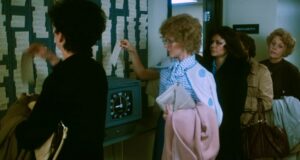
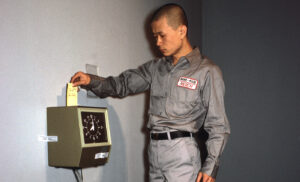
Besides the 9 to 5 song and film, another thing that happened in the United States during the year when Hsieh was checking-in every hour, on the hour, 24 hours a day, was that Ronald Reagan was elected as president and sworn into office, ushering in an era of neoliberal reform and aggressive union busting. His concerted attacks on workers’ rights would destroy much of what the US labor movement had fought for, and his time in office came with a sharp acceleration in income inequality.
In the years since, the rise of post-Fordist precarity has vastly changed the time of work. While many waged workers in the US are still brutally exploited by the mechanized clock—think of Amazon workers having to urinate in bottles while on the job, to avoid getting fired for clocking too many minutes of break time—there is also, for many, an increasing problem in the blurring of the distinction between work time and nonwork time: work becomes an all-the-time condition, for which Hsieh’s 24/7 performance of constant arrival in 1980–1981 comes to seem incredibly prescient.
To linger on this historical shift in work-time politics, I turn now, with deep sadness, to 5 to 9, the new version of the 9 to 5 song, which Parton recorded for a Squarespace commercial that aired during the 2021 Super Bowl. Have you seen it? It’s heart wrenchingly grim. The original was crystal clear on the conditions of worker exploitation: “9 to 5, yeah, they got you where they want you . . . It’s a rich man’s game, no matter what they call it, and you spend your life puttin’ money in his wallet.” In the new version of the song, all proletarian discontent is evacuated as Parton sings a creepy ode to the contemporary gig economy, where workers clock-off from their dreary day jobs at 5 p.m., and then they work, joyously, on their entrepreneurial dreams—with their own Squarespace websites—from 5 p.m. until 9 a.m.
The original 9 to 5 lyrics were furious in their insistence that “You’re just a step on the boss-man’s ladder.” In 5 to 9, the fury has been replaced with a cheery invitation to “be your own boss, climb your own ladder!” It’s disguised as a promise of self-empowerment, but this image of being your own ladder points to the extent to which workers have been atomized as part of an historical project that has sought to destroy all solidarity. 40 years ago, Parton’s song acknowledged that collective discontent can lead to collectivized dreams for something else: “You’re in the same boat / With a lotta your friends / Waitin’ for the day / Your ship’ll come in / And the tide’s gonna turn / An’ it’s all gonna roll your way.” Today, her song tells workers that they should be excited to let work completely saturate the hours that used to constitute nonwork time: “5 to 9, you keep working, working, working / ‘Cause it’s hustlin’ time, a whole new way to make a livin’!”
There is a cautionary tale here about what can happen when struggles to improve certain aspects of working conditions ultimately leave pro-work ideology unchallenged. Back in 1980, the flexibilization of work hours at the end of the 9 to 5 film was depicted as a win for workers, but Parton’s new 5 to 9 song tells us that discontent with the drudgery of the “nine to five” work day can be easily absorbed into the system of exploitation, so that new forms of atomized and flexibilized precarity—with the constant encroachment of work into nonwork time—can be sold back in colorful, celebratory packaging, as an image of “freedom.”
Looking back on the eight-hour movement (which the “nine to five” work day is a product of), the antiwork feminist theorist Kathi Weeks has argued that historical struggles for reduced work time have too often been divorced from a broader critique of the wage labor system.[2] In contrast with these previous struggles, Weeks outlines the possibilities of a contemporary demand for shorter working hours, without a decrease in pay, that would be rooted in antiwork politics and postwork imaginaries. Such a demand would seek not only to achieve less work time, but also to confront the racial and gendered divisions of labor, and the social organization of domestic and unwaged reproductive work, which the wage labor system has both depended on and invisibilized.
Weeks shows that previous struggles to reduce work hours have often presented the rationale that such a reduction would allow for more time to be spent with family. Wanting to distance the demand for less work from a further perpetuation of the ideology of the family, she returns to a popular slogan from the eight-hour movement which said, “Eight hours labor, eight hours rest, and eight hours for what we will.” The “what we will” displaces family duty as a core rationale for shorter work hours, allowing instead for the demand to be animated by the prospect of pleasure. Weeks also points to an interesting ambiguity in the phrase “time for what we will,” which might refer to “time for what we want” but also to “time for what we will into existence.” She writes, “is it more about getting what we wish for or about getting to exercise our will? Is it a mater of being able to chose among available pleasures and practices, or being able to constitute new ones?”[3] In the new time movement that she’s proposing, the demand would be
“for more time not only to inhabit the spaces where we now find a life outside of waged work, but also to create spaces in which to constitute new subjectivities, new work and nonwork ethics, and new practices of care and sociality.”[4]
Having grown up in Taiwan, Hseih arrived in the US in 1974, when he was 24 years old. He had been working at sea on an oil tanker, and when it docked near Philadelphia, he jumped ship and took a taxi to New York. He lived for the first 14 years without legal status; as part of the undocumented immigrant labour force that the US economy has long been dependent on, he made a living by cleaning floors and washing dishes for cash in downtown restaurants—usually during “after-work” hours, while others slept.
If a pro-work ethic ends up getting snuck into the 9 to 5 film as an unquestionable given—with the workplace reforms at the end ultimately re-affirming productivist values—Hsing’s contemporaneous performance piece was far less redemptive, and far more invested in noninstrumentaliszed time. It was an enactment of punctual arrival as an emptied-out gesture, wherein the artist is always arriving on time without doing anything else in time. “It’s not the question about ‘how’ to pass the time. Just passing time. This is my philosophy,” Hsieh said in a 2017 interview. “You see, tons of talented artists out there, and I thought of myself as a talentless idiot.. but then I thought, my talent is wasting time.”[5]
The Time Clock Piece was one of five year-long performance works that Hsieh completed while his existence in the US was illegalized. The final one, which he did from 1 July 1985 until 1 July 1986, involved not doing any art (“I do not do ART, not talk ART, not see ART, not read ART, not go to ART gallery and ART museum for one year. I just go on in life”).[6] After the no art piece, he embarked on a 13-year work, in which he would make art but “not show it PUBLICLY.”[7] That work ended on 31 December 1999, and since then he has stopped making art. “I don’t do art any more,” he said in a 2009 interview, “I don’t have other things to say.” Instead, he remarked, “I’m just doing life.”[8]
[1] See 9to5: The Story of A Movement, directed by Steven Bognar and Julia Reichert (PBS, 2019); and Karen Nussbaum, “Why 9 to 5 Still Resonates Today,” Jacobin Magazine, March 2022, https://jacobinmag.com/2022/03/9-to-5-film-documentary-jane-fonda-dolly-parton.
[2] Kathi Weeks, The Problem With Work: Feminism, Marxism, Antiwork Politics and Postwork Imaginaries (Durham, NC: Duke University Press, 2011), pp. 151–174.
[3] Weeks, The Problem With Work, p. 169.
[4] Weeks, The Problem With Work, p. 174.
[5] KaiChieh Tu, “Doing time, passing time, wasting time: An interview with Taiwanese-American artist Tehching Hsieh,” The Theatre Times, August 2017, https://thetheatretimes.com/time-passing-time-wasting-time-interview-taiwanese-american-artist-tehching-hsieh/.
[6] See Tehching Hsieh, One Year Performance, 1985–1986: https://www.tehchinghsieh.net/oneyearperformance1985-1986.
[7] See Tehching Hseih, 1986–1999 (Thirteen Year Plan), 1986–1999: https://www.tehchinghsieh.net/thirteenyearplan1986-1999.
[8] Barry Schwabsky, “Live Work,” Frieze 126 (October 2009).
This text reworks ideas and material from presentations previously given at public events with Tehching Hsieh at the TATE Modern in 2017 and at BAK, basis voor actuele kunst in 2022. The author wishes to thank the artist, as well as the organizers and attendees of those events.

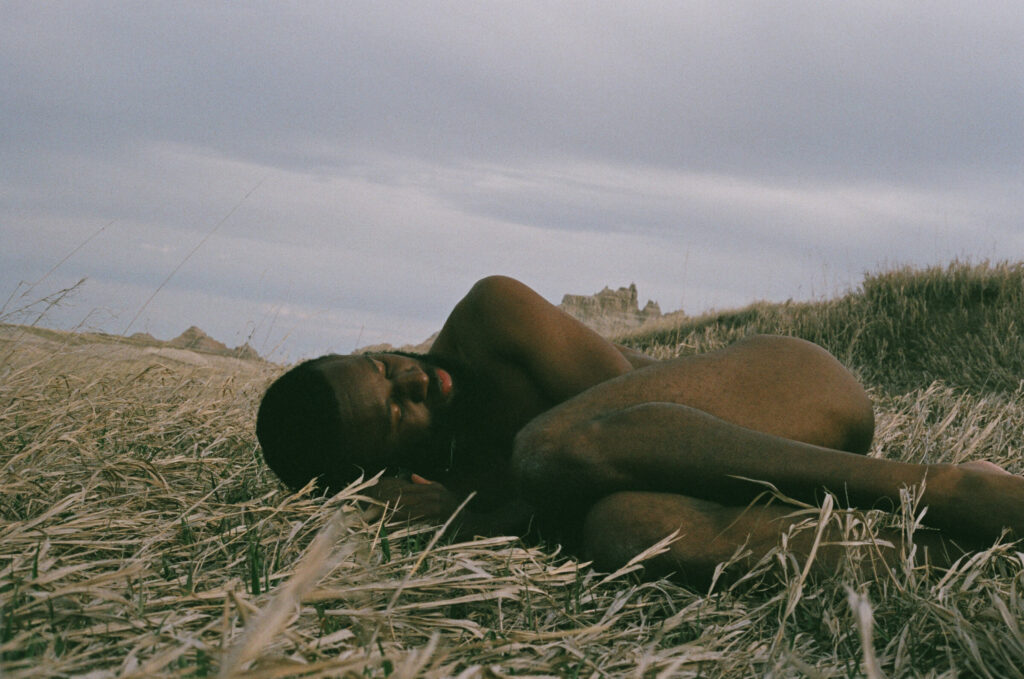;)

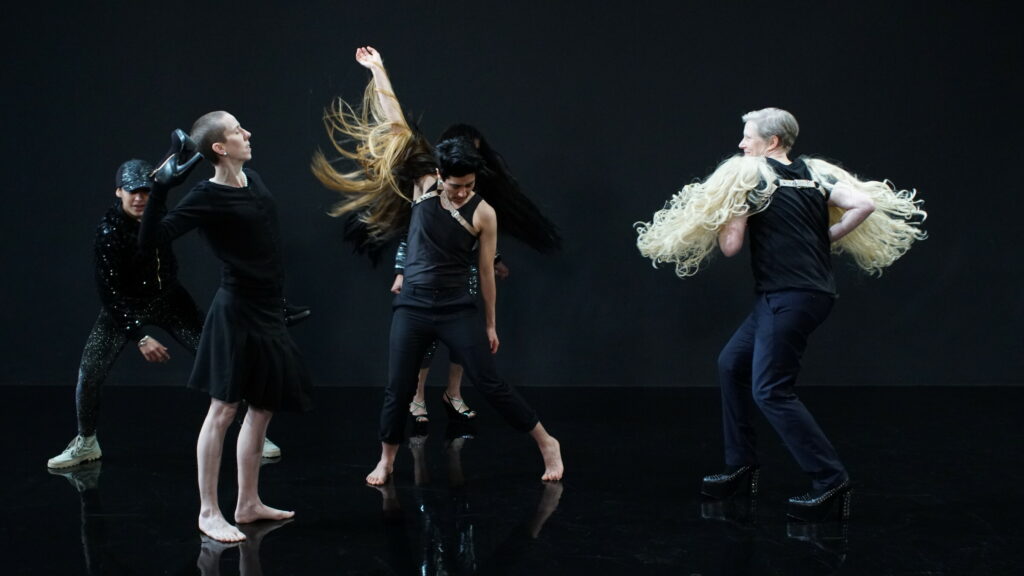;)

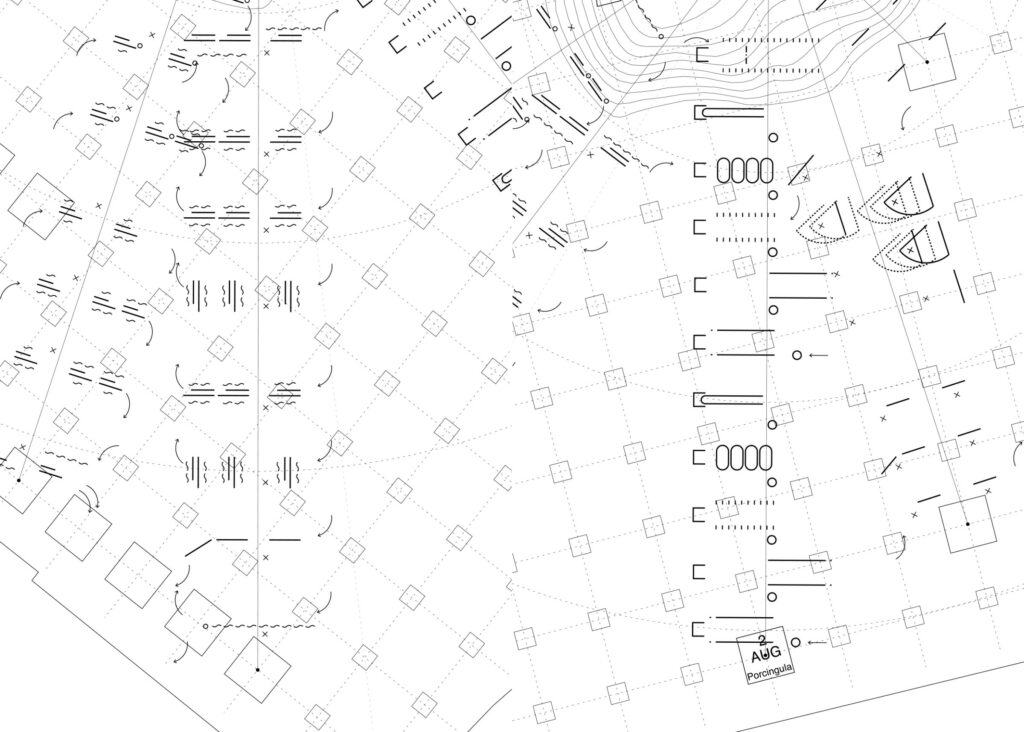
;)

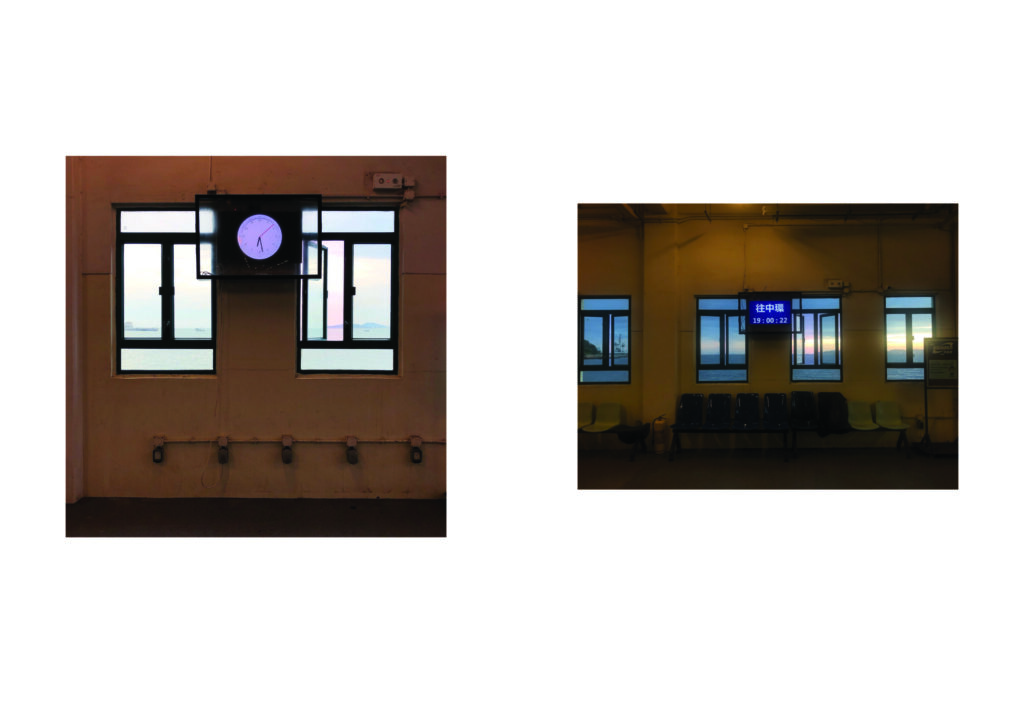;)

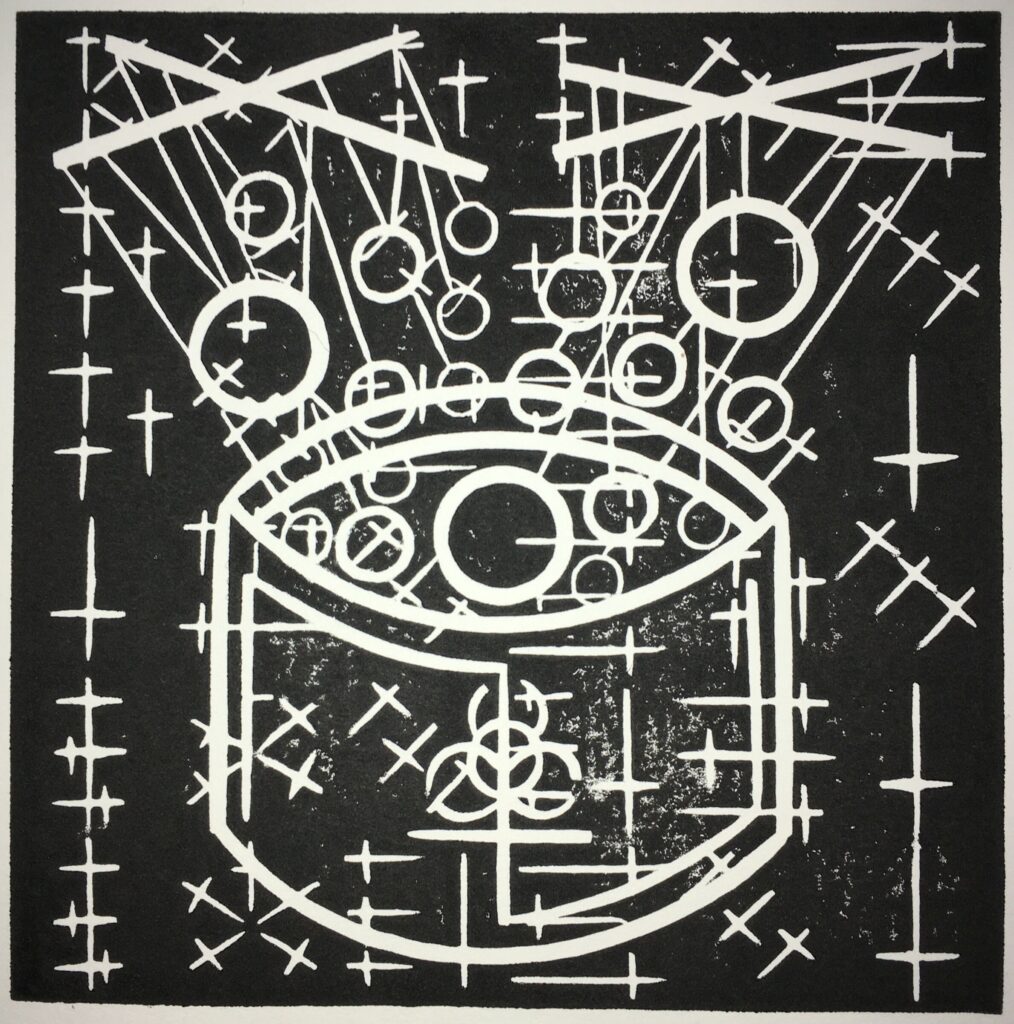;)

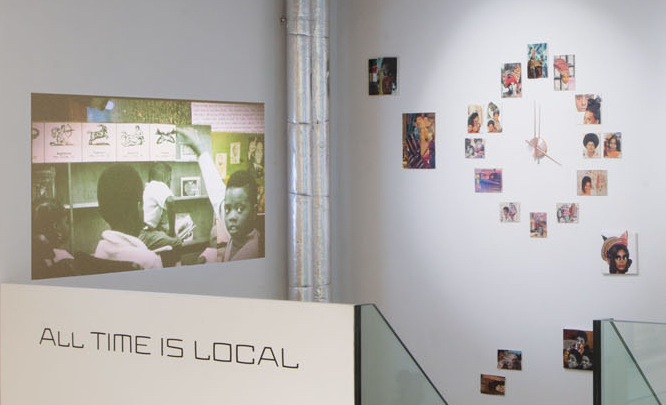
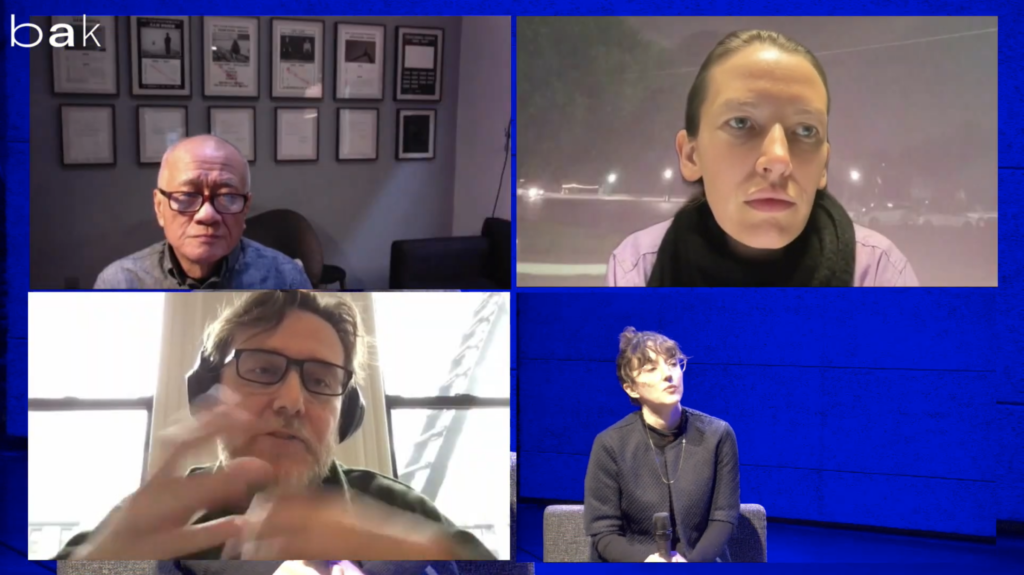;)

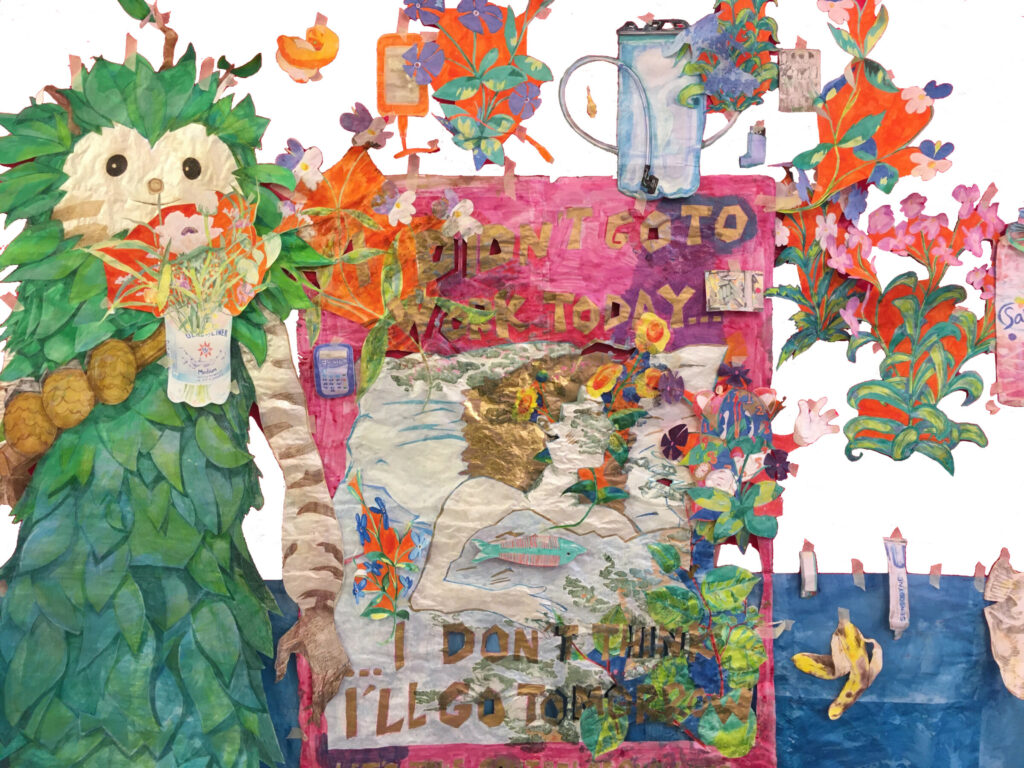;)
